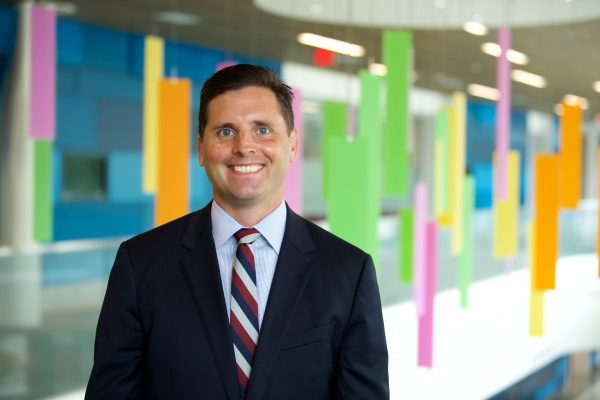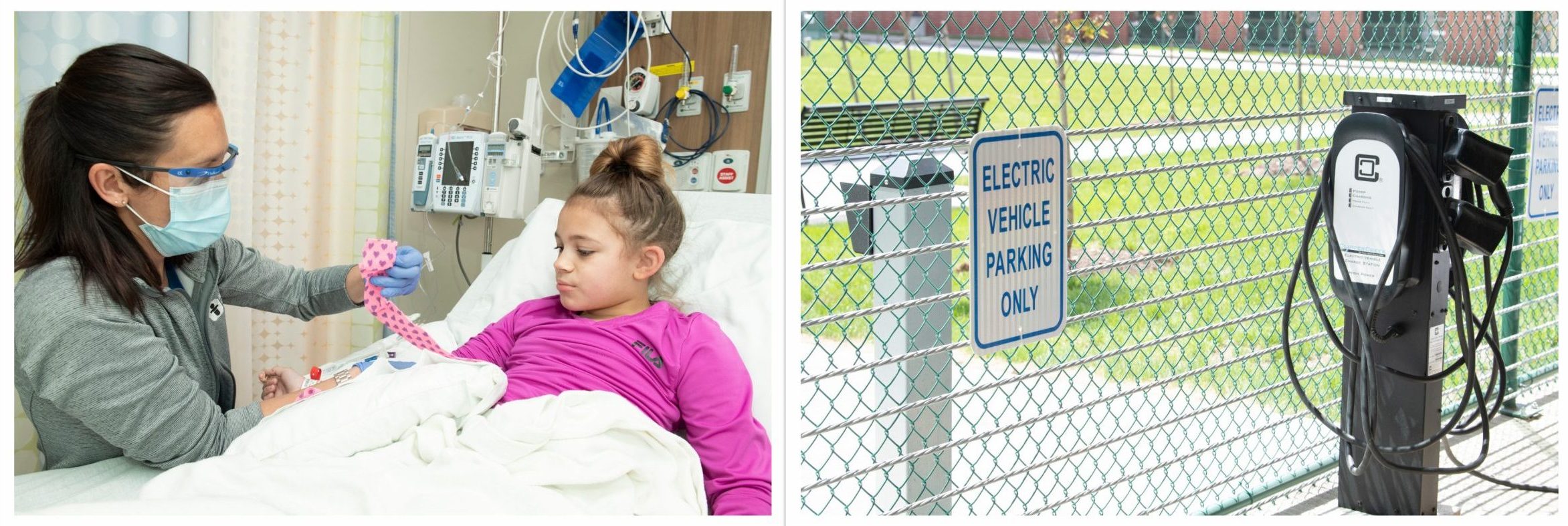
Akron Children’s is on a mission to reach a zero-carbon future to promote a cleaner, safer, healthier environment for our patients, employees and communities.
Earth Day may come once a year, but green practices for a cleaner, safer, healthier environment is at the forefront each and every day at Akron Children’s.
The hospital has made it a priority to implement green building initiatives, reduce energy demands, recycle and limit pollution to promote a healthier planet for our employees, patients and communities.
“We have one Earth to share, and we need to reduce our carbon emissions from further damaging the atmosphere to ensure a safe and healthy planet for future generations,” said Brian Lapolla, vice president of facilities operations and supply chain at Akron Children’s. “Akron Children’s is a healthcare leader, and it is our responsibility to educate and promote greener practices, implement renewable clean energy and reduce carbon emissions.”
Akron Children’s is doing its part by developing a sustainability plan to reach a zero-carbon future. As part of the Better Health Partnership workgroup, the organization is working with surrounding hospital systems, including University Hospitals, Metro Health and Cleveland Clinic, to reduce carbon pollution, decrease costs and improve climate-related health outcomes for patient communities.
The hospitals track and compare data points of their carbon footprints to share best practices and learn from each other on how to be better stewards of the environment.
“We’re building momentum to move forward with greener, cleaner initiatives that promote health and wellness for future generations,” said Lapolla. “Whether it’s health care, higher education, corporate business or government, we all need to make it our goal to be carbon neutral to protect our planet.”
Here are a few of the ways Akron Children’s is making green practices a part of its everyday operations. After all, the hospital’s commitment to overall wellness correlates to better health for everyone in the end.

Brian Lapolla, Akron Children’s vice president of facilities operations and supply chain, leads the charge for greener practices on Earth Day and every day.
Green building and design
One of Akron Children’s biggest achievements in green practices was constructing Kay Jewelers Pavilion to meet the current and future health care needs of children using sustainable building practices and design.
“Kay Jewelers Pavilion was the first critical care tower in the area to achieve LEED (Leadership in Energy and Environmental Design) certification by the U.S. Building Council,” said Lapolla. “Now, these practices have become a teaching tool and methodology for sustainable construction and ongoing operations for Akron Children’s and other hospitals.”
To achieve these strict standards, the design and construction team incorporated lean principles in every step of the project, including:
- Sustainable site selection designed with a storm water drainage system to reduce water contamination.
- Incorporating low-flow sinks and toilets, and faucets with hand sensors, to reduce water use.
- Installing LED light fixtures, Energy-Star equipment and creating a Building Automation System to improve energy efficiency.
- Recycling construction materials, and using sustainably sourced materials and low-emission paints, adhesives and flooring.
As a result, the hospital increased water and energy efficiencies, reduced carbon emissions and its demand on utilities. In fact, the organization reduced energy consumption by 38% when compared to the national average of hospital systems.

The green practices used to design and construct Kay Jewelers Pavilion have become a teaching tool and methodology for sustainable construction and ongoing operations for Akron Children’s and other hospitals.
Decreasing energy demands
In addition, Akron Children’s integrated a Building Automation System (BAS), a centralized control system of the campus’ HVAC, electrical and lighting systems, to improve energy efficiency, reduce costs and carbon emissions, and increase safety.
By physically connecting all of the major facilities on campus, Akron Children’s can now automate its utility usage based on demand. It also can program schedules for use instead of relying on someone to turn off the lights or turn down the heat each night.
For example, while the main hospital operates 24/7 and requires utilities at all times, other departments, such as outpatient clinics, don’t. Through the BAS, the facilities department is able to schedule mechanical, water and electrical utilities only when they’re needed, instead of having them on at all times.
“The BAS enables us to operate our facilities appropriately and safely without being wasteful,” said Lapolla. “Since 2014, the footprint of our main campus in Akron has grown by 63%, but we’re proud to report since then our total utility consumption has decreased by 4%.”
Reducing energy waste
Another way Akron Children’s is reducing energy use is through a partnership with Akron Energy Systems, which provides steam for heating the campus.
The hospital tied its infrastructure with Akron Energy Systems, creating a steam condensate loop. The hospital receives the steam directly from the energy plant, circulates it through multiple facilities and the condensate that collects after use is then returned and recycled, instead of wasted.
Not only does recycling the water create cost savings for the organization, but it also reduces carbon emissions in the atmosphere each year.
“A partnership with the City of Akron and a joint investment in the necessary infrastructure have provided a sustainable energy model for other cities to learn from,” said Lapolla. “It reduces the hospital’s demand on energy, while also decreasing the carbon footprint by putting resources back into the system to be redistributed to all energy customers.”

Akron Children’s is leading the way to promote greener practices by its employees and patient families, such as installing electric vehicle charging stations in its parking garages and sustaining a 40% reduction in waste anesthesia gas.
Promoting greener practices
Akron Children’s also is leading the way to promote greener practices by its employees and patient families.
One way is through electric vehicle (EV) charging stations. The hospital has installed EV stations in Exchange, Bowery and Buchtel parking decks so employees and families can plug in and charge their electric vehicles, which also reduce carbon emissions.
In addition, staff in our Anesthesiology Department has sustained a 40% reduction in WAG (waste anesthesia gas) since this time last year without any change in patient care. They were able to cut these greenhouse gases by turning down gas flows and minimizing nitrous use. That’s the equivalent of the department reducing local driving by 82,130 miles!
As the hospital looks to the future, Lapolla and his team continually ask the question: “How can we reduce or offset our energy demand, while always maintaining safe, high-quality facilities that support the highest level of care for our patients, families and staff?”
What they’ve found is all of these green initiatives have proven extremely successful, but Akron Children’s still has more work to do because it is not stopping until the hospital reaches a carbon-neutral goal.
“If we don’t promote cleaner, more sustainable practices, the impacts of climate change will have a negative impact on everybody,” said Lapolla. “We have an opportunity at Akron Children’s to model the way for our communities and ensure a healthy planet for future generations to enjoy.”










